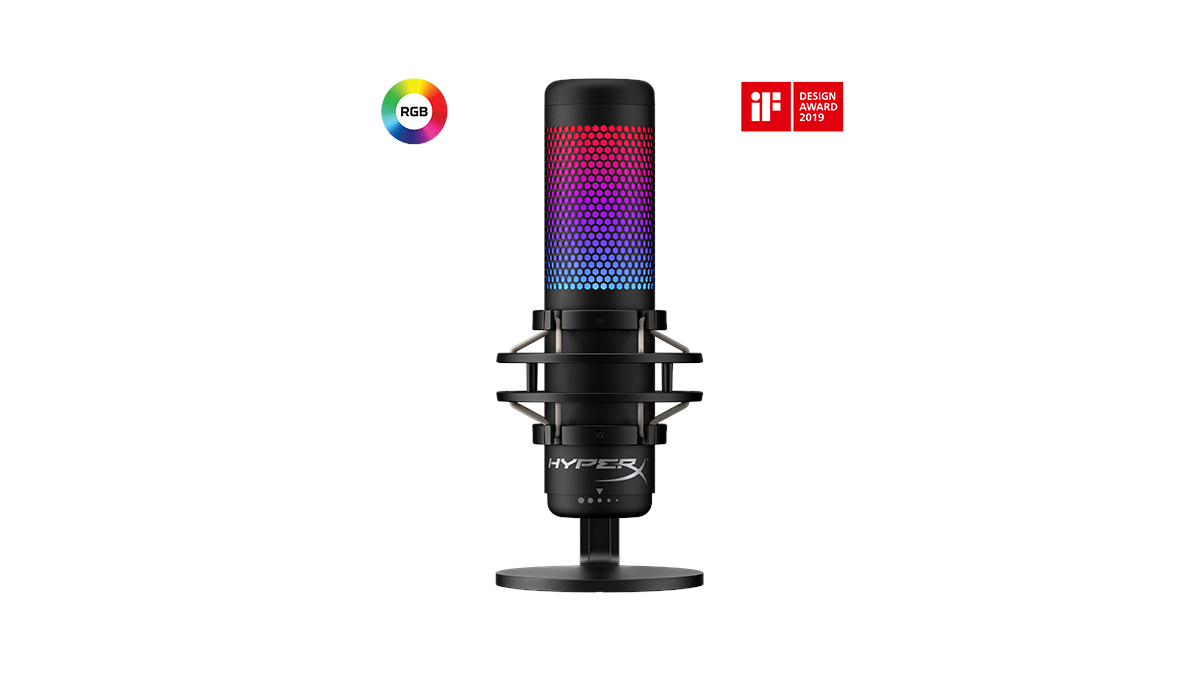HyperX offers a new mic for streamers and content creators with the Quadcast S!
Introduction and Setup
A little over a year ago I reviewed the initial HyperX Quadcast microphone.
As you can see in my previous review, I was very enthusiastic about the build, look, and quality of the Quadcast. With that being said, I had high hopes when HyperX contacted me about an updated version of the microphone, the Quadcast S.
Unboxing the Quadcast S, I was first stuck with the similarities it has to the previous model. A good, solid, sturdy basic black design and a classic studio microphone look. A solid and weighty metal base to keep it firmly planted on your desktop, with the main microphone suspended by sturdy elastic straps to absorb any shocks or movements.
The capacitive touch button to mute and unmute the mic at the top is still included. I have found this to be the most used feature so far. It is nice in the age of COVID to be able to quickly mute out coughs or noises that may arise from cranky children or pets while recording.
One of the new upgrades is the updating of the USB port from a Micro connector to USB-C, which I welcome with open arms as USB Micro connectors are historically horrible and prone to failure in a relatively short time (even if you purchase a higher grade cable). Another change is the color indicator that tells you if the Quadcast S is active or not. The previous model kept to a solid red color indicator whereas the new S model allows you a full RGB spectrum and the patterns you are accustomed to if you have used HyperX’s Ngenuity software. This may not change much for pro users, but gamers looking to match their gear will be extremely pleased.
Once plugged in Windows 10, I was easily able to find the proper drives and add it to the list of hardware available to all of my streaming and recording apps. I was using it for a Zoom meeting within the first hour of installation with no issues and it sounded amazing. I was the envy of my work colleagues for not sounding like I was at the bottom of the ocean. I did play a bit with the Ingenuity software to try some different colors but decided I like the wave pre-set that came pre-loaded. In all, it was a very simple and rewarding experience that offered professional-quality sound without a lot of tweaking.
Specifications
Power consumption:
5V 220mA (white light)
Sample/bit rate:
48kHz/16-bit
Element: Electret condenser microphone
Condenser type: Three 14mm condensers
Polar patterns: Stereo, Omnidirectional, Cardioid, Bidirectional
Frequency response: 20Hz–20kHz
Sensitivity: -36dB (1V/Pa at 1kHz)
Cable length: 3m
Weight: Microphone: 254g
Shock mount and stand: 360g
Total with USB cable: 710g
Lighting:
RGB (16,777,216 colors)
Light effects:2 zones2
Connection type:
USB-C to USB-A
Headphone Output
Impedance: 32 Ω
Frequency response: 20Hz – 20kHz
Maximum power output: 7mW
THD: ≤ 0.05% (1kHz/0dBFS)
SNR: ≥ 90dB (1kHZ, RL=∞)
Final thoughts and Recommendations
The Quadcast S from HyperX is another solid addition to their selection of gaming and streaming gear. It is a solid piece of tech that may only be a slight improvement over the previous model, so you may not want to spend another $160 to upgrade. Also, beware of online price gouging for this microphone due to some stock limitations because of COVID.
That being said, if you are looking to get a new microphone for gaming, streaming, content creating, or meetings, the HyperX Quadcast S should be at the top of your list. It is so solid and feature-packed that it simply cannot be avoided.
A sample of the Quadcast S was made available by HyperX. The opinions expressed in this review are the author’s alone and not that of the manufacturer or our editorial board.





